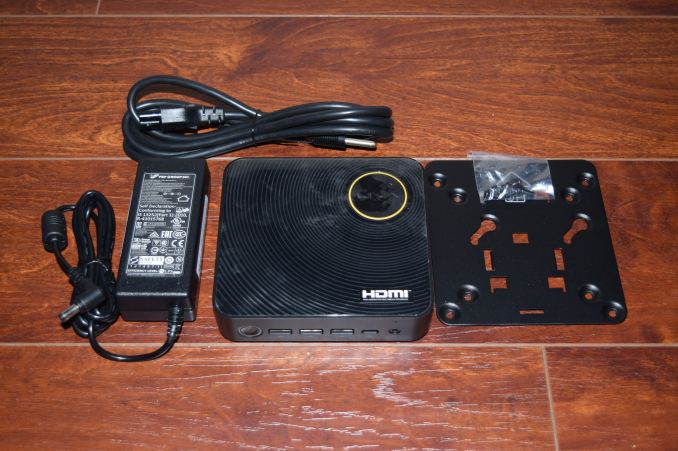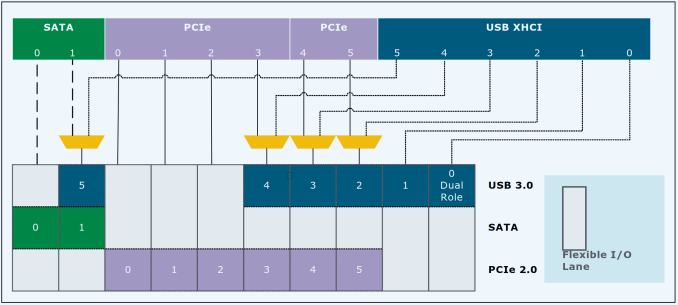ECS LIVA Z Fanless Dual-LAN Apollo Lake UCFF PC Review
by Ganesh T S on March 30, 2017 8:00 AM EST
The market for UCFF (ultra-compact form factor) PCs has seen tremendous growth since the introduction of the Intel NUCs in early 2013. Various motherboard and system vendors have their own offerings in this space. ECS started selling their own UCFF PCs under the LIVA brand in 2014. The initial focus was on the low end, with units based on the Intel Bay Trail and Braswell platforms. The lineup evolved to accommodate Core M-based units as well as systems in the mini-STX form factor. Today, we are taking a look at the ECS LIVA Z. This fanless Apollo Lake system targets the low-end market segment, and aims to differentiate itself by supporting two LAN ports.
Introduction and Product Impressions
Traditional UCFF PCs (such as the BRIX from GIGABYTE and the Beebox from ASRock) have stayed close to the Intel NUC form factor. ECS had experimented with a smaller form factor (Mini-Lake) in the first-generation LIVA, as well as the LIVA X, and LIVA X2. The LIVA Z, however, adopts a board form-factor similar to that of the Intel NUCs.
The feature set and pricing of the LIVA units make it target the developing and cost-sensitive markets. The LIVA Z is no different. Intel's Apollo Lake SoCs improve upon Bay Trail and Braswell by adopting a newer microarchitecture (Goldmont) for the CPU cores and also getting fabricated in a more power-efficient / mature 14nm process. In the consumer market, the Goldmont cores are exclusive to the Apollo Lake family. The SoCs target the netbook and nettop markets, and it is no surprise that ECS has adopted the netbook variants for the fanless LIVA Z models.
The LIVA Z comes in three variants,corresponding to the three members of the Apollo Lake mobile SoC family (6W TDP) - the Pentium N4200, or the Celeron N3450, or the Celeron N3350. Our review sample, the LIVA-ZN33 is based on the Intel Celeron N3350. The unit ships with 32GB of eMMC on the board, but, it was insufficient to enable the installation of all our benchmark programs. Therefore, we evaluated the PC in two different configurations - the base one with Windows 10 installed on the eMMC and used for typical workloads such as media playback, and a configuration with a M.2 SATA SSD for office workloads. The full specifications of our review configurations are summarized in the table below.
| ECS LIVA-ZN33 Specifications | |
| Processor | Intel Celeron N3350 Apollo Lake (Goldmont), 2C/2T, 1.1 GHz (Turbo to 2.4 GHz), 14nm, 2 MB L2, 6W TDP |
| Memory | Kingston CBD16D3LS1KBG/4G DDR3 4GB 11-11-11-28 @ 1600 MHz |
| Graphics | Intel HD Graphics 500 |
| Disk Drive(s) | SanDisk eMMC DF4032 (32 GB; eMMC v5.0-compatible) ADATA Premier SP600 SP600NS34 (128 GB; M.2 Type 2242 SATA III; MLC) |
| Networking | Intel Dual Band Wireless-AC 3165 (1x1 802.11ac - 433 Mbps) 2x Realtek RTL8168/8111 Gigabit LAN |
| Audio | 3.5mm Audio Jack, 1x Digital Microphone Capable of 5.1/7.1 digital output with HD audio bitstreaming (HDMI) |
| Display | 1x HDMI 1.4a 1x mini-DisplayPort 1.2 |
| Miscellaneous I/O Ports | 3x USB 3.0 Type-A 1x USB 3.0 Type-C |
| Operating System | Retail units come barebones, or with OS depending on SKU. Our unit was the non-OS version, but we installed Windows 10 Pro x64 |
| Pricing (As configured) | $180 (eMMC / No OS) $220 (eMMC / Win 10 Home x64) $250 (with M.2 SATA SSD, as configured / No OS) |
| Full Specifications | ECS LIVA Z Specifications |
The ECS LIVA-ZN33 package comes with a 65W (19V @ 3.42A) AC adapter and a VESA mount / screws in addition to the main unit. Windows 10 is the only officially supported OS, and all the drivers were downloaded on our review unit from the ECS website.
One of the interesting hardware components in the LIVA-ZN33 is the integrated digital microphone. This allows the end user to configure it as an always-listening machine (if needed), without the need to connect an external microphone. The other selling point is the availability of two GbE RJ-45 ports. Intel Ethernet controllers would have sweetened the deal, but, ECS has taken the cost factor into consideration and opted for Realtek controllers.
The industrial design is attractive and the unit feels solid. The chassis is made of plastic (not uncommon at the targeted price point). The internal heat sink which faces the bottom lid, however, is solid metal, and possesses good characteristics for effective heat transfer from the SoC. It would have been nice if the design allowed for the generated heat to dissipate via convection. In any case, we will take a look at the effectiveness of the thermal design in a later section.
Platform Analysis
The specifications of the Intel Celeron N3350 indicate that the SoC can support up to 6 PCIe 2.0 lanes, 2 SATA ports, and 8 USB ports. The break-up of the high-speed I/O lanes is interesting in the context of the availability of four USB 3.0 ports (3x Type-A + 1x Type-C) as well as two GbE LAN ports in the LIVA Z
Intel Celeron N3350 HSIO Block Diagram [ Courtesy : Intel Pentium and Celeron Processor N- and J- Series Datasheet - Volume 1 of 3 (PDF) ]
The distribution of PCIe lanes in the LIVA Z is as below.
- PCI-E 2.0 x1 port #3 In Use @ x1 (Realtek RTL8168/8111 PCI-E Gigabit Ethernet Adapter)
- PCI-E 2.0 x1 port #4 In Use @ x1 (Intel Dual Band Wireless-AC 3165 AC HMC WiFi Adapter)
- PCI-E 2.0 x1 port #5 In Use @ x1 (Realtek RTL8168/8111 PCI-E Gigabit Ethernet Adapter)
Since the used PCIe lanes are muxed with the USB 3.0 lanes, and, there are four USB 3.0 ports in the system, it stands to reason that at least one USB 3.0 port has its bandwidth shared with the PCIe lanes / networking interfaces. At the price point targeted by the LIVA Z, this is hardly an issue.
In the table below, we have an overview of the various systems that we are comparing the ECS LIVA-ZN33 against. Note that they may not belong to the same market segment. The relevant configuration details of the machines are provided so that readers have an understanding of why some benchmark numbers are skewed for or against the ECS LIVA-ZN33 when we come to those sections.
| Comparative PC Configurations | ||
| Aspect | ECS LIVA-ZN33 | |
| CPU | Intel Celeron N3350 | Intel Celeron N3350 |
| GPU | Intel HD Graphics 500 | Intel HD Graphics 500 |
| RAM | Kingston CBD16D3LS1KBG/4G DDR3 4GB 11-11-11-28 @ 1600 MHz |
Kingston CBD16D3LS1KBG/4G DDR3 4GB 11-11-11-28 @ 1600 MHz |
| Storage | SanDisk eMMC DF4032 (32 GB; eMMC v5.0-compatible) ADATA Premier SP600 SP600NS34 (128 GB; M.2 Type 2242 SATA III; MLC) |
SanDisk eMMC DF4032 (32 GB; eMMC v5.0-compatible) ADATA Premier SP600 SP600NS34 (128 GB; M.2 Type 2242 SATA III; MLC) |
| Wi-Fi | Intel Dual Band Wireless-AC 3165 (1x1 802.11ac - 433 Mbps) |
Intel Dual Band Wireless-AC 3165 (1x1 802.11ac - 433 Mbps) |
| Price (in USD, when built) | $180 (eMMC / No OS) $220 (eMMC / Win 10 Home x64) $250 (with M.2 SATA SSD, as configured / No OS) |
$180 (eMMC / No OS) $220 (eMMC / Win 10 Home x64) $250 (with M.2 SATA SSD, as configured / No OS) |


















30 Comments
View All Comments
Systab - Thursday, March 30, 2017 - link
Win10 only support is worrisome but expected.The obvious question is how well would it run some sort of Linux server version and what driver problems one would encounter with Win7?
mjeffer - Thursday, March 30, 2017 - link
I'm guessing there are probably Linux drivers for all the components in this machine and would be 100% fine with Linux. Just don't expect ECS to provide any help with it.StevoLincolnite - Thursday, March 30, 2017 - link
Would have been great to see some gaming benchmarks. Especially eSports titles like Overwatch, StarCraft, Counterstrike etc'.nathanddrews - Thursday, March 30, 2017 - link
Not worth it:https://youtu.be/fN8paf1RtHY
Even if it had Iris Pro graphics, the anemic dual-core can't deliver a playable experience. As a Kodi/Retroarch box, it's probably perfect. If you can get Linux running on it, it would also make an excellent pfSense box - but the lack of a quad-core means foregoing some more advanced plugins.
extide - Tuesday, April 11, 2017 - link
pfSense runs on FreeBSD. not Linux, which makes driver support a BIT trickier -- but I bet you could still get it all up and running.BrokenCrayons - Thursday, March 30, 2017 - link
OMG it's adorable cute and for $220, the price isn't bad at all. It badly needs the M.2 SSD to make it usable since ECS skimped on the eMMC drive, but it looks like a really nice little system you could mount on the back of a monitor to keep clutter down. The fact that it's fanless AND has good thermal performance are huge selling points for me.JoeyJoJo123 - Thursday, March 30, 2017 - link
Perfect box for pfSense.[X] Dual Lan
[X] Built in WiFi (not necessary, but nice bonus)
[X] Small
[X] Cost Effective
[X] Built in flash memory (32GB is enough for pfSense and minimal logging)
[X] Support for m.2 SSDs.
[X] Passive heat dissipation design
Realtek LAN controllers are a bummer, but it's OK given that throughput/availability issues shouldn't be strained as most internet connections in the US are measured in tens of megabits, rather than saturating the full gigabit connection anyways.
Also wished it was a bit better than a mobile Celeron, but that is plenty for most internet connections and without too many pfSense add-ons. At the end of the day it is 4core/4threads and can burst up to 2.2Ghz on some single-threaded loads, any more and it might not have been able to be passive at this small form factor.
Really like this, and I'll keep my eye on it.
takeshi7 - Thursday, March 30, 2017 - link
This would be a great homebrew router/NAS combo. I would still get a separate WiFi AP though. That 1x1 configuration on the built in WiFi wouldn't cut the mustard.nathanddrews - Thursday, March 30, 2017 - link
This is the 2C/2T model.JoeyJoJo123 - Thursday, March 30, 2017 - link
Yes, Einstein. I'm not talking about the dual core reviewed here, I was talking about the N3450 model which is also available.https://ark.intel.com/products/95596/Intel-Celeron...
4 cores / 4 threads.